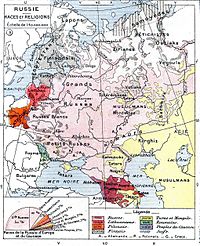European Russia

Russia in Europe and Asia with current administrative divisions (de facto boundaries[note 1]).
European Russia is the western part of Russia that is a part of Eastern Europe. With a population of 110 million people, European Russia has about 77% of Russia's population, but covers less than 25% of Russia's territory. European Russia includes Moscow and Saint Petersburg, the two largest cities in Russia.
The boundaries between continents are largely a matter of convention. However, the eastern boundary of Europe is generally considered to be along the Ural Mountains, the Ural River, the Caucasus Mountains, the Turkish Straits and the border with Kazakhstan. The Southern part of European Russia has some small areas that are geographically south of the Caucasus Mountain range, and therefore are geographically in Asia; this includes the city of Sochi.
The other, eastern, part of the country is part of northern Asia, and is known as North Asia, also called Asian Russia or Siberia. Europe is also a subcontinent within Eurasia,[1] making the whole of Russia a part of the Eurasian continent.
Contents
1 Demographics
2 History
3 Alignment with administrative divisions
4 See also
5 References
Demographics

Ethnic map of the European Russian Empire prior to the outbreak of World War I
Russia is not proportionately populated between its larger Asian portion, which contains about 23% of the country's population, and its smaller European portion, which contains about 77%. The European portion contains about 110 million people out of Russia's total population of about 144 million in an area covering nearly 4,000,000 km2 (1,500,000 sq mi); (making it by far the largest European country) an average of 27.5 people per km2 (70 per sq mi).[2]:6[2]:10
The eastern portion of Russia, mostly encompassing Siberia, is part of Asia and makes up more than 75% of the territory with 22% of the country's population at 2.5 people per km2 (6.5 per sq mi).[2]:6
History
The term “European Russia” was used in the Russian Empire to refer to traditional East Slavic territories under Russian control, including what is now Belarus and most of Ukraine (Dnieper Ukraine).[citation needed]
Alignment with administrative divisions
The administrative districts (on a large scale called federal districts) of the Russian Federation do not exactly line up with European Russia, but they are decent approximations, depending on exactly how Europe is defined. There are two major trends, one to use administrative divisions north of the mouth of the Ural River and one to draw an imaginary line from the Ural River, through the city of Yekaterinburg.[citation needed]
The following administrative districts are overwhelmingly European:

Federal districts of Russia
| Name of district |
Area (km²) |
2017 population |
Population density |
Continent notes |
|
|---|---|---|---|---|---|
Central Federal District |
650,200 |
39,209,582[3] |
59.658 |
Europe |
|
North Caucasian Federal District |
170,400 |
9,775,770[3] |
56.58 |
Europe |
|
Northwestern Federal District |
1,687,000 |
13,899,310[3] |
8.25 |
Europe |
|
Southern Federal District[note 1] |
447,900 |
16,428,458[3] |
33.46 |
Europe |
|
Volga Federal District |
1,037,000 |
29,636,574[3] |
28.63 |
Predominantly Europe |
|
Ural Federal District |
1,818,500 |
12,345,803[3] |
6.86 |
Predominantly Asia |
|
| Sum of 6 Federal Districts[note 2] |
3,992,500 |
108,949,694[3] |
27.22 |
Predominantly Europe |
|
| |||||
See also
- North Asia
- Caucasus
- Russian Far East
- Siberia
References
^ Hans Slomp (2011). Europe: A Political Profile. Retrieved 2014-09-10..mw-parser-output cite.citation{font-style:inherit}.mw-parser-output q{quotes:"""""""'""'"}.mw-parser-output code.cs1-code{color:inherit;background:inherit;border:inherit;padding:inherit}.mw-parser-output .cs1-lock-free a{background:url("//upload.wikimedia.org/wikipedia/commons/thumb/6/65/Lock-green.svg/9px-Lock-green.svg.png")no-repeat;background-position:right .1em center}.mw-parser-output .cs1-lock-limited a,.mw-parser-output .cs1-lock-registration a{background:url("//upload.wikimedia.org/wikipedia/commons/thumb/d/d6/Lock-gray-alt-2.svg/9px-Lock-gray-alt-2.svg.png")no-repeat;background-position:right .1em center}.mw-parser-output .cs1-lock-subscription a{background:url("//upload.wikimedia.org/wikipedia/commons/thumb/a/aa/Lock-red-alt-2.svg/9px-Lock-red-alt-2.svg.png")no-repeat;background-position:right .1em center}.mw-parser-output .cs1-subscription,.mw-parser-output .cs1-registration{color:#555}.mw-parser-output .cs1-subscription span,.mw-parser-output .cs1-registration span{border-bottom:1px dotted;cursor:help}.mw-parser-output .cs1-hidden-error{display:none;font-size:100%}.mw-parser-output .cs1-visible-error{font-size:100%}.mw-parser-output .cs1-subscription,.mw-parser-output .cs1-registration,.mw-parser-output .cs1-format{font-size:95%}.mw-parser-output .cs1-kern-left,.mw-parser-output .cs1-kern-wl-left{padding-left:0.2em}.mw-parser-output .cs1-kern-right,.mw-parser-output .cs1-kern-wl-right{padding-right:0.2em}
^ abc Vishnevsky, Anatoly (15 August 2000). "Replacement Migration: Is it a solution for Russia?" (PDF). EXPERT GROUP MEETING ON POLICY RESPONSES TO POPULATION AGEING AND POPULATION DECLINE /UN/POP/PRA/2000/14. United Nations Population Division, Department of Economic and Social Affairs. pp. 6, 10. Retrieved 2008-01-14.
^ abcdefg "Population 1 January 2015 Estimate – Federal State Statistics Service Russia". Federal State Statistics Service Russia.
Coordinates: 55°N 40°E / 55°N 40°E / 55; 40



Comments
Post a Comment